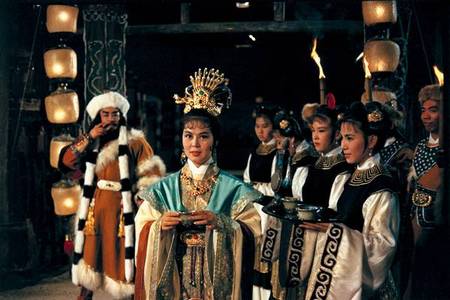| Although she worked for several different studios, Linda Lin Dai is closely associated with the Shaw Brothers, where she became a contract player in 1961. All of the films presented in this retrospective of her career are Shaw productions, and this memorial to Linda Lin Dai owes much to the current re-release of a considerable number of classic Shaw films on DVD and VCD. In fact, several of the films screened at the HKIFF were projected from the DVDs. (Only Diau Charn and The Lotus Lamp were un-restored prints. The Lotus Lamp has since been restored and released on DVD.) Linda Lin Dai, Shaw Brothers, the Chinese diaspora of the late 1950s and early 1960s, and the twenty-first century “rediscovery” of Hong Kong cinema’s pre-Bruce Lee “golden age” all fit together seamlessly in these five films that showcase the way in which fantasy and star image work together to create a bankable product for the displaced Chinese globally then and now. The retrospective pays tribute to Linda Lin Dai’s talents, but also highlights Shaw Brothers’ decision to open its vault, let out its treasures, and appeal to a new generation of filmgoers who may only know these films from late night reruns, if at all. However, this opening of the vaults also introduces Linda Lin Dai’s Shaw films to viewers outside of the Chinese community, promising new fans from around the world, and a reexamination of her extraordinary screen presence in a very different transcultural context.
In the late 1950s and early 1960s, Linda Lin Dai perfectly matched the vision Shaw Brothers had of itself as a studio and its ideal audience sophisticated, cosmopolitan, erudite, elegant, modern, and decidedly bourgeois, or aspiring to be all those things. Educated in Mandarin and English, Linda Lin Dai could by-pass the local Cantonese-speaking world of Hong Kong to speak to a transnational Chinese audience in America, Europe, Taiwan, and the Nanyang. She could play the classical Chinese beauty or the modern career woman. If Nancy Kwan in The world Of Suzie Wong (1960) represented a Hollywood image of Hong Kong in the guise of a Chinese prostitute in need of an American savior (willing to “sell out” sexually to a more powerful West), Linda Lin Dai certainly struck a different, if no less vulnerable, pose. On screen she often played the heroine who sacrificed herself for the greater good, and, in her personal life, a rocky marriage and mental illness led to her premature demise.

Before her death at the peak of her career, Linda Lin Dai helped to cement Shaw Brothers’ reputation as the home of beautiful female stars, elegant costumes and sets, lavish color, and widescreen spectaculars. Melodramas, musicals, opera films, and romances showcased female stars for a global Chinese audience that still included more than its fair share of housewives, young working women, and schoolgirls with some disposable income as well as families and single men. While television (as a domestic appliance) had sapped the female film audience in places like the United States after World War II, Hong Kong, with rising incomes, immigrants with money, cramped living quarters, and television in its infancy, found a fan-base for female-centered narratives. Similar audiences, with a sizeable number of female and family viewers, existed throughout the Chinese-speaking world, and Shaw beauties like Linda Lin Dai dominated production. Men could enjoy their loveliness and women could fantasize about their achievements onscreen and off.
|
